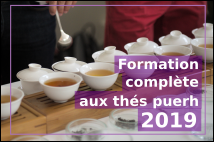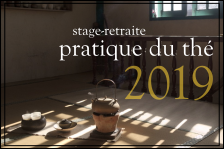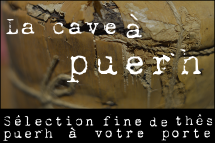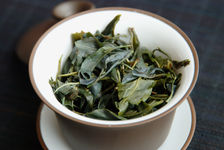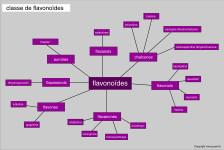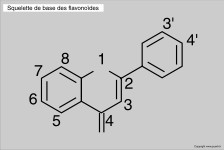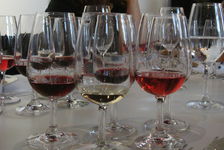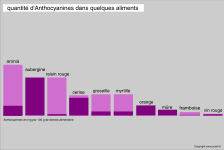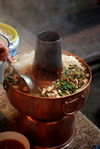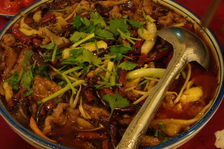 This page is not a real translation but just an automatic translation generated by computer of the original article, written in French language! Its not good... but better than nothing!
This page is not a real translation but just an automatic translation generated by computer of the original article, written in French language! Its not good... but better than nothing!Want to help us do diffuse puerh tea culture in english, by providing a better (or corrected) translation?
Please contact us!

There Yunnan rare teas, coloring or purple hues. When we are lucky, we can cross such leaves on an ancient tree in the heart of the forest or visit a tea garden. Then, we find them sometimes compressed into cakes or bricks. Prized for their flavor, rarity and natural goodness, these teas are sold, often expensive, under the names of Zi Juan (紫娟), Zi Ya (紫 芽) or simply Zi Cha (紫 茶), tea purple sometimes also called crimson tea in French.
As is often what is said here and there, the discourse of sellers or what is written on the wafer is very inaccurate, so I investigated more deeply about the origin, nature and properties of these teas purple ...
So good trip in the amazing world of purple leaves.
Purple teas, a rare mutation, natural and sought the Camellia Sinensis
One often hears that all teas come from the same tree, the famous Camellia Sinensis. If somehow this is not entirely false and that all stem from the Camellia Sinensis tea, there are a multitude of different types, especially in old trees from which the Yunnan puerh, and rely nearly 200 different varieties.
In green teas and oolong there already different cultivars , more or less the equivalent of what the grape is to wine, sometimes developed by man through a long process of selection and crossings. These trees are maintained in the state of shrubs and replaced regularly, they do however, have little opportunity to interbreed naturally and give birth to new varieties of tea.
Located at the heart of the forest or in areas of high biodiversity, old tea trees have been growing for hundreds of years in Yunnan totally integrated with the natural ecosystem. These trees are the source of many intersections and natural mutations, particularly (but not solely) responsible for the major differences you notice aromas of Yunnan to another.


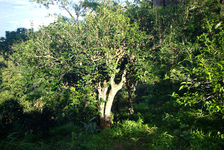

- 1. Tea tree growing in the middle of the forest in YiWu
- 2. Tea Garden modern Nanuo
- 3. Old tea plantation in the mountains Jinuo
- 4. purple leaves on a tea tree YiWu
From a natural mutation relatively rare, so it happens sometimes that produces tea leaves or buds ... purple! This color is due to anthocyanin pigmentation which we will discuss later in the article, colorful natural substance responsible in particular for the color of some plants such as blueberry, blackberry or cherry and some tea tree produce in quantity and important addition to chlorophyll, responsible for its green color of the tea leaves. This purple color generally does not touch the buds or young leaves that surround the buds, but sometimes this range may be wider violet and spread to the entire tree.
However, this mutation did not plant a visual result, but of course affects the flavor of tea as a result. Up there in a very short time we did not pay much attention to this and violet leaves, few were either thrown when sorting is mixed among the other leaves and found themselves in haphazard among the patties. Even today many producers do not heed these rare purple leaves, the amount is too low to be a special production, and integrate with their sisters so green in the middle of their cakes. Others are particularly interested in these sheets, especially for their singular taste and as we will see below for benefits, and teas produced exclusively from purple leaves.
These teas are sometimes called Chinese tea three colors : Violets on the tree, the leaves dry and once worked become indeed a dark green almost black which sometimes found slight glints purple, then resume color and change into something rich green once infused. Liquor for its part, usually a copper gold intense and deep. It is often small productions or from certain soils where there is a higher concentration of natural tea leaves and purple as these are picked separately and pressed apart, more often in tea gardens of purple, where trees were obtained by cuttings of tea older having the ability to produce purple leaves.


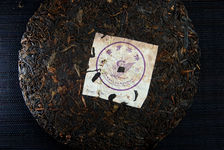
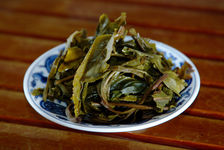
- 1. Violet Leaves Zi Cha, a tree YiWu
- 2. Mao worked cha purple leaves (Wang Bing, YiWu)
- 3. Galette Zi Cha compressed (Haiwan)
- 4. Leaves violet infused once (Shi Dai Mao)
Sold in bulk, compressed into cakes or bricks, these teas are usually called Cha Zi (紫 茶) which means purple tea or tea purple, or sometimes Ya Zi (紫 芽), meaning purple buds. There is however no strict definition of these terms, which do not involve a cultivar (family tea set) but any specific mutation resulting in staining of bud or leaf. Zi Ya , meaning bud purple is supposed to cover only the case of trees bud and in general the first three leaves are purple. Extremely rarely, if ever, made of pure buds (given the rarity of purple bud) patties Ya Zi have all the time in general more purple buds that simply called tea < i> Cha Zi (meaning tea purple), with respect to any tea leaves that have a purple color.
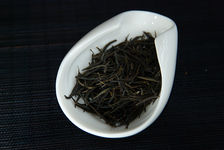
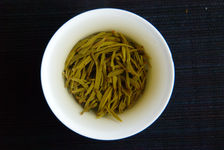
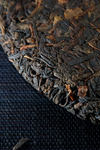
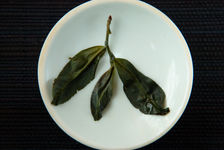
- 1. Pure purple buds (Zi Ya)
- 2. Pure purple buds (Zi Ya) infused
- 3. Slab containing purple buds (Haiwan)
- 4. Leaf infused Cha Zi (Wang, Yi Wu)
As some claim the superiority of green tea or pure white bud, by its scarcity, which is absurd, some vendors advocate the superiority of purple bud tea tea purple, which is no less absurd and n has no basis in taste. As with any other tea cakes some particular purple tea is very good while the others are mediocre. Because it is important to note again that these names are not in any of the cultivars (varieties) but involve different specific mutations producing natural coloring (anthocyanin) and therefore behind the words Cha Zi or Ya Zi can be as various multi-centenary old trees of different kinds, that more or less intensive crops bouturées on these trees, all growing in soils and varied.
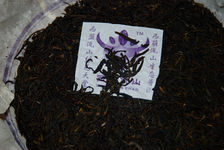
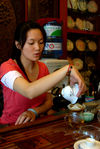
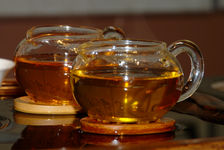
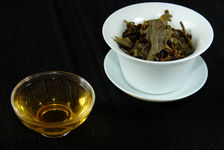
- 1. Galette Zi Cha (cha ye Yeshan)
- 2. Tea with a vendor Zi Cha
- 3. Comparison of two deep golden liquor Zi Cha ancient trees
- 4. Zi Cha infused (Wang Bing, WiYu)
Purple tea, although it is often sold dear, is not only not a guarantee of quality but has no real flavor character. If we can still note some permanence teas purple, like some sweetness in the taste, bitterness totally absent or less pronounced than other puerh, and some of the Hui gan fees may recall aged teas, it n ' there is no real "taste Zi Cha" or "taste Zi Ya" and the flavors of these teas are varied according to the true nature of the trees, the land from which they come, and the quality of work sheets. Many teas tasted violets under this article are proven and totally mediocre and not worth the price in any way. Others, such as the four teas below for their part, not only presented some originality but true qualities. So little break tasting before continuing our exploration of this article and teas purple, starting with some purple high quality teas, natural mutation from the tea plant.
We begin with an excellent cake produced by Wang in 2009, an author and publisher of Kunming and already presented in the full aricle producer.
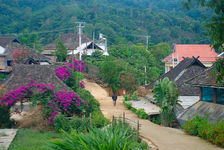
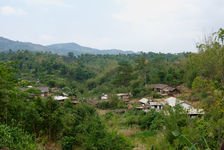
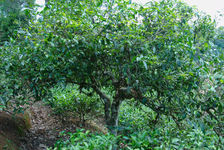
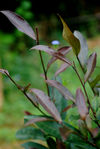
- 1. Tai Di containing trees with purple Yi Wu
- 2. Tea leaves on a purple tree Wu Yi
- 3. Tea Tasting at Purple Bing Wang Yi Wu
- 4. Tea Tasting violet in Wang Bing Yi Wu
This tea is a blend of violet tea from natural mutation collected and selected by Wang from different tea gardens Yi Wu trees that make up this cake are usually quite young, a few decades, and gardens from which they are not usually contain only a handful of these trees.
 Chargement du thé...
Chargement du thé...Three years later, a new special series of this tea purple, made exclusively from picking spring is pressed by Wang at my request. This time under the name of Zi Cha Yo, the name used to refer to the local tea Wu Yi tea which means fat purple sheen of the leaves, it is accompanied by a series of high-end 3 other cakes 2012 This producer.
 Chargement du thé...
Chargement du thé...
Now another taste purple high quality tea this time from the Pu'er region, selected by Professor Wang also to Kungming, who was behind the original purple Or we tasted earlier.
It is a 250g brick produced by Lao zhi hao (老 枝 亳) whose leaves are from old trees Jingu, in the region of Pu'er this time, and which are also the result of a natural mutation of tea.
Although possessing a character quite distinct from previous tea, we find some common features, which are beginning to draw an outline of the family puerh (Pu Er tea) purple. I refer specifically to a certain roundness of which raises suspicions wispy aftertaste fresh ...
 Chargement du thé...
Chargement du thé...Also in the field of tea taste purple old trees now another tea cake purple high end, pressed also to Professor Wang in 2010. Produced by Yeshan cha ye (野山 茶 业) this tea comes from ancient trees of the mountain Ximeng Wa, always in the Pu'er region, only 20 km from the Burmese border. This tea plays a certain way with the same weapons as the previous tea, large and round sobritété, intensity and complexity of flavor, thick liquor and freshness in soupsons hui gan, while pushing even further the printing of équibibre and valuable purity.
 Chargement du thé...
Chargement du thé...
Continue this culinary discovery with teas less upscale and sold at prices more popular, but still quality (I will skip the innumerable violets tea undrinkable, it has little interest), beginning a big tea production, pressed Haiwan in 2007 under the brand Jiajia, originally designed for especially popular teas.
Haiwan, a major producer which I have already spent a article has produced annually cakes Zi Ya (purple buds) between 2005 and 2007 the latter being the 2007 vintage. Faithful to the tradition of Haiwan, it is a blend of different leaves and buds designed by Bing Zou Liang, founder and master blender Haiwan.
Although Nomee Zi Ya (purple buds), this cake contains either buds but some might be so could be more objectively Nomee tea purple. Widely different from other teas tasted this cake reminds us that purple tea is a wide range and does not necessarily taste identié accurate. In the hands of Zou Liang Bing, these purple leaves are much more masculine, crude, and leave aside for the round copper exlater purple tea's ability to play the cool aftertaste and pretend to be more elderly than they are ...
 Chargement du thé...
Chargement du thé...To end this little tea tasting purple I want to talk about this amazing cake Cha Zi first prize. Across all wafers Cha Zi cheap I could taste proved hateful and obviously have been produced for more color than flavor. This cake produced by Dai Shi Mao Jingu exception, and although it is still clearly inferior to others and Zi Cha tested this tea is quite correct that we take a real pleasure to drink.
 Chargement du thé...
Chargement du thé...
Purple Yunnan teas are generally worked as puerh (Pu Er tea) teas (see article From the tree to the cake ), especially because it is the tradition in Yunnan. There are also generally not fermented, which is understandable due to the high price of violet leaves. He however there's always exceptions to everything, and producers who seek to exploit the potential of how different these purple leaves.
This is particularly the case of a small regional producer De Hong, which produces a rare tea, amazing and very upscale purple colorations. There is a tea made from a wild variety of tea large leaf such as that used to produce puerh (Pu Er tea) wild trees, but places to be worked like a puerh (Pu Er tea) The leaves are finely fermented in a way inspired Yunnan black tea (Dian Hong). The result is amazing and absolutely stunning!
 Chargement du thé...
Chargement du thé...Zi Juan, the new Yunnan Purple tea cultivar
Different studies have made summers in China around these teas purple, and in particular to isolate a given cultivar. Already in the 50s researchers research center on Yunnan tea discovered in the region Nanuo trees with both buds and violet leaves. In 1985 an expedition back to Nanuo in order to isolate a type of tree purple without success. In May of the same year they discover the heart of their own plantation Zhen Nan, in the region of Menghai, a tea with stems, leaves and buds purple.
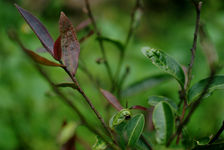
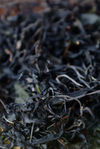
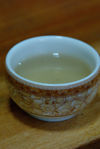
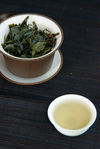
- 1.ShiTouZhai Village in the mountains Nanuo
- 2. Mountain Nanuo
- 3. Old tea tree Nanuo
- 4. Violet Leaves Zi Juan (YiWu)
This cultivar is then isolated and named, Zi juan (紫娟) was born. It is characterized by a rod partially purple, purple-green leaves elliptical elongated buds in purple duvet abundant. Once worked mao cha becomes the black-and intense violet liqueur produced by the infusion of a violet-gray amazing. Ideal conditions of culture stand in a warm, moist place, a land whose pH is between 4.4 and 5.5, but Zi Juan is particularly well adapted to different soils, grows easily between 800 and 2000 meters altitude and has excellent resistance to cold, excess heat, and insects.
Be planted in 1986 by 0.9 Are asexual reproduction (90 square meters!) Of this new cultivar, which remain extremely rare until the 2000s or early seed Juan Zi will be produced by the research center of Yunnan and marketed. Although there are now nearly 200 hectares of Zi Juan through Yunnan, mainly in the Xishuangbanna region of Pu'er, Lincang and Baoshan, it remains a rare tea, expensive and highly sought after for its taste but also its properties.
Unlike other teas purples, Zi Juan all from the same strain are defined and flavor character common to all. It is first of all a very very gentle and without any bitterness, with sharp and spicy aroma unique only really refer to any other tea. It is intense, and very light on the palate fresh, refreshing, and if we found not the body and the strength of some puerh (Pu Er tea) (Zi Juan trees have almost exclusively under 10) there is a wealth and taste complexity that few other teas of Yunnan (including green tea) may claim points seem to oscillate between spicy floral and fruity.
Of the rarity of this cultivar, its very recent arrival on the market and thus the poor performance of these young trees purple and the prohibitive price which cuttings and seeds are sold (a small producer told us it bought its seeds Zi Juan more than 1 RMB () (9 eurocents) seed in 2006), the real Zi Juan is now a tea that is not so common to find in the trade. The unfortunate few kilograms Zi Juan that produces a number of producers are saving micro-office private productions are destined to become collectors, or to be offered ... when pressed, because often Zi Juan is kept in a state of mao cha precious that we do offer a taste to friends and visitors as some noble wine never leave the caves in which they arise.
This scarcity of Zi Juan , however, should tend to disappear gradually in the coming years, more and more producers interested in this cultivar, often enticed by the prospect of large profits with purple hues, and trees planted in the years 2004-2007 beginning to allow harvest correct. Some producers mao cha wholesale offer already today Zi Juan in kg, at a high price but still reasonable, but unfortunately the quality of Zi Juan great production that I could taste left quite poor and not worth far smaller productions that I could drink like the first cakes Zi Juan Wang or the mao cha as not commercially produced by Jino Cha Shan Chang.
The founder of Jinuo Shan Chang Cha, small producer mountain Jinuo which I devoted an article there's some time it is not only a great tea connoisseur but also a crazy passionate agrnonomie. Skillfully juggling between green teas, black and white through the oolong and puerh (Pu Er tea) he continues to experiment with new approaches to culture and work sheets in the vast tea garden that has mountain Jinuo.
In the 2000s it crashes and an experimental garden of the new tiny purple cultivar whose production is of the order of a few kilograms per year. 2008 will be pressed and thirty cakes, which take place in the center of beautiful boxes in which they will be surrounded by six tuos pure white buds.
This rare item has not been released and there are few who have had the opportunity to taste the cake in it. I myself have had the chance to taste the mao cha (uncompressed) Juan Zi Shan Cha Chang Jinuo that produced in 2010.
 Chargement du thé...
Chargement du thé...Now to the first productions of Juan de Wang Zi, producer whom I already spent Article Full .
Small farmer from the village of Wu Yi, Wang planted in 2006 a number of plans Zi Juan, whose first leaves were harvested in 2009 and whose only thirty cakes were pressed cake 200g 2010.
 Chargement du thé...
Chargement du thé...Three years later, the trees are still in their adolescence and the annual production is minimal. Profile aromatic teas that are very similar result, but with a small gain in strength and endurance. Here is the latest leaves (2012) produced by these trees.
 Chargement du thé...
Chargement du thé...If Zi Juan , still rare today, and is prized for its rarity and unique taste, the popularity of this tea also comes from substances it contains, including a high rate of anthocyanins and flavonoids, substances and antioxidant health benefits.
Anthocyanin and Flavonoids behind the color molecules that are constantly demonstrate the benefits
It is indeed a natural pigment, anthocyanin, which is responsible for the purple color of the leaves and buds of the tea, whether Zi Juan , Zi Ya or Cha Zi . The color of this flavonoid pigment covers a wide range from red to violet through blue, hence its name (from the Greek anthos: flower and kuanos: dark blue) and its color depends mainly its structure as well as acidity of the medium in which it appears. It is found in various plants, most commonly in flowers such as purple or fruits such as cherry, blackberry, blueberry, juniper berry, plum or red grapes but it also happens that the found in the roots ... and leaves.
Outside plant or purple fruit where the high concentration of anthocyanins makes the presence of this pigment particularly evident, we find traces in many other plants. We note, for example, increased production of anthocyanin on very young plants, before the latter do not produce chlorophyll, anthocyanin then providing the plant with protection against ultra-violet rays. Production of anthocyanin then decrease in proportion to the production of chlorophyll. In autumn, when the plant loses its chlorophyll is the opposite occurs, and the orange color that are of the leaves is due to the disappearance of chlorophyll, revealing the color of anthocyanin and carotene.
Or anthocyanins, with flavones, flavanones and catechins are what are called flavonoids, a class of secondary metabolites (molecules produced by a plant without being vital to the latter) defined by a structure derived from the of flavone (phénylbenzopyrone), which have been identified to date more than 4000 varieties and whose properties have been the subject of countless research over the past 15 years. These molecules were originally discovered summers in the 30s by Albert Szent-Gyorgyi, who received the Nobel Prize in 1937 for discovering specifically vitamin C and flavonoids, and have demonstrated their biochemical properties. Since these molecules have ceased to occupy researchers from all countries, and hundreds of studies tend to show various beneficial properties such as antibacterial activity, vasodilatory, anti-inflammatory, antiallergic, antiviral and so on .
a beneficial effect on cardiovascular problems, to an explanation of the French paradox?
It really began to take an interest in flavonoids and conduct extensive research on these molecules in the 1990s with the discovery in the research community of what has been called the "French paradox" (the paradox French): There is indeed in France, particularly in the Southwest, a level of cardiovascular mortality than elsewhere, despite a particularly high consumption of saturated fats, yet recognized as a major cardiovascular risk factor.
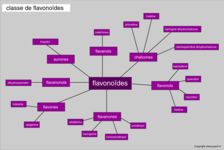
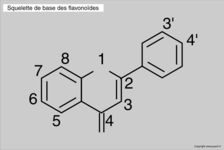
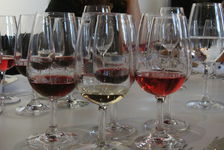

- 1. The class of flavonoids
- 2. Skeleton based flavonoids
- 3. Red wine as an explanation for the French paradox?
- 4. The French Paradox, a case that challenges the scientific (décidasse)
Resulted in studies that everyone has more or less heard in France and suggest that moderate consumption of red wine, on the order of one or two drinks per day [1][2] and that regular consumption of fruits such as apples ("Eat apples!") [3] have a beneficial effect on health and tend to reduce the risk of cardiovascular disease (myocardial infarction, etc.) or neurodegenerative disease (for Alzheimer's, Parkinson's, etc.). It was indeed first and logically attributed this paradox French consumption of red wine, higher in France than elsewhere. But red wine from the grape of the same color, has a high concentration of flavonoids, and these are molecules that are found at the front of the stage to try to explain this French exception. Since then, hundreds of studies around the globe seem to confirm these results the benefits arising from the consumption of foods rich in flavonoids which we attribute such a reduction in the permeability of blood vessels, improving the function of vitamin c, a positive effect on the prevention of cardiovascular disease and excessive weight gain.
To the mass of studies on the subject, experts have proposed an English meta-analysis [4] for this review from 133 clinical studies on the action of different subclasses of flavonoids on cardiovascular disease. This study show that the consumption of flavonoid-rich products such as chocolate, soy protein, and tea have a beneficial effect on the dilation of the arteries (confirmed by 10 studies), may reduce blood pressure (17 studies) and that cholesterol (4 studies). It is important to note firstly no certainty is advanced that these results are many flavonoids in foods and not others components (such as caffeine in tea with also influence blood pressure), and that for the vast majority of flavonoids studied too little evidence summers together to allow valid conclusions.


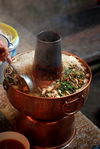
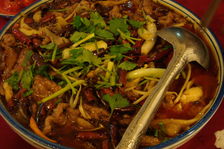
- 1. Quantity of Anthocyanins in some commonly consumed foods in the West
- 2. China Market
- 3. Traditional cuisine Chinese
- 4. traditional Chinese cuisine
Two major European research projects are currently the subject of flavoides within the 6th European Framework Programme, it is the project FLAVO (Flavonoids in Fruit and Vegetable; Their Impact on Food Quality, Nutrition and Human Health) and the draft FLORA (Favonoids and related phenolics for healthy Living using Orally Recommended Antioxidants). The aim of the latter is to highlight the beneficial effects of flavonoids against cardio-vascular cancer and other degenerative diseases and involves researchers from various fields such as chemists, researchers in cell biology, geneticists but also nutritionists, epidemiologists and researchers in physiology.
In this context a study by Dr Marie-Claire Toufektsian conducted at the University of Grenoble in collaboration with other centers participating in the FLORA project and published in the Journal of Nutrition [6] relates specifically to the beneficial influence of anthocyanins (the pigment flavonoids responsible in particular for the purple violet teas) on cardiovascular disease. For 8 weeks in rodents separated into two groups and were fed respectively with a rich purple corn anthocyanins and with a corn-free substance. The researchers then studied the differences in the onset and progression of artificially induced myocardial infarction. The results were very promising, the rats received a high intake of anthocyanins (approximately 13 times higher than the average consumption of anthocyanins in the West) showed a greater resistance to infarction, and the size of the latter was reduced by almost 30%.
Another study [7] on the positive influence of the consumption of flavonoids on a diet too fat, for its part, suggests that on some subjects intake of flavonoids limit the deterioration of endothelial function induced by a high fat meal .
Historically after an attempt to understand this "French paradox", many studies on flavonoids are well on the influence of these substances on cardiovascular disease, but a number of other recent studies tend to show benefits of flavonoids in other areas such as allergies, obesity, retinal problems or Parkinson's disease.
benefits that far outweigh the issue cardiovascular ...
A study in Laboratory of Food Science and Technology Jiangnan and published in 2008 [8] shows such positive action of luteolin, a flavonoid, on the protection of neurons and would limit the damage Parkinson can be via inhibition of the activity of microglia. Another study (in vitro) published the same year and performed at the Department of Pharmacology, Kyungpook University in Korea [9] when to suggest a positive effect of flavonoids on allergic disorders by inhibiting the release of histamine. Researchers from Zhejiang University in China [10] For their part, highlighted the protective effects of flavonoid fisetin on the west stress induced by UV, thus suggesting a potential protector against the onset of cataract .
Other studies focus on the positive influence of flavonoids on the issue of obesity . Some of these studies suggest that certain flavonoids such as flavanones have a beneficial effect on lipid metabolism [11]. A Dutch study conducted over 14 years on more than 4,000 subjects [12] suggest that for its contribution of flavonoids may have a positive influence on maintaining a normal weight for women, while it has no significant influence been shown for the male population.
Various research also suggest an inhibitory effect of flavonoids with the emergence and development of certain cancers . At present we do not know yet for sure if those are the flavonoids themselves are responsible for this protective effect, or if it is the result of an interaction of different substances in plant products which are studies.
Because so many research suggests undeniably positive impact on the health of the consumption of flavonoids, much remains to be done to understand in detail the reasons for this positive influence and the mechanisms that are responsible.
A operating on the body to be explored ...
We read, for example, often, especially on the Internet and among vendors "health products" as anthocyanins and flavonoids are generally more powerful antioxidants, molecules capable of counteracting the negative action of oxidants such as free radicals, their greatly benefits from this property. We consider the particular favor and against cellular aging by improving elasticity and density of the skin and help avoid redness by strengthening the small vessels of the skin. In comparison with other antioxidants some believe that proanthocyanidins (a flavonoid compound found in various plants such as grapes) would advantage of the most effective antioxidants and antioxidant properties have 20 times more powerful than vitamin C and 50 times more powerful than vitamin E.
Researchers at the University of Orgeon however, and that they do not call into question the benefits of flavonoids are the cause of a study [13] which in turn tends to show the opposite. If they believe flavonoids have many antioxidant properties in vitro, these molecules are strongly absorbed once transformed, thereby reducing void see their antioxidant properties and their action against free radicals. Assimilated foreign flavonoids and would then be processed quickly eliminated.
This study, this time bearing more on the consequences of the observed consumption of flavonoids but an attempt to understand their functioning is not uninteresting and opens new avenues. One theory is that the backlash against the body metabolized flavonoids induce the activation of enzymes favor the elimination of mutagens and carcinogens. Well according to these researchers and flavonoids decline the activation of nitric oxide synthesis, possessing vasodilator and antihypertensive.
If you believe this study, flavonoids and would not be responsible for observed benefits but have a trigger effect, helping the body to protect itself. Thus, according to this study and a diet too rich in flavonoids would be useless, harmful view, and it would a regular consumption of flavonoids in reasonable quantities to observe benefits.
Again these differences of viewpoint suggests a lack of understanding to date on the functioning mechanisms of flavonoids and their influence on our metabolism. If by numerous international studies the past 20 years have brought to light the beneficial effect of flavonoids on health, we can hope that the next 20 will better understand the mechanisms that induce these molecules. Meanwhile opinions differ, we unanimously recommend the regular consumption of fruits and varied while that industry parapharmaceutical product cheerfully food supplements enriched with flavonoids many French excuse their consumption of red wine popularization articles Scientists read between the lines ...
Change course and finally back to the tea, particularly in Kenya where it does not pass this phenomenon flavonoids, and where it would benefit many to get wheat ... precisely from a purple tea house, TRFK306 /1.
TRFK306 /1, Kenya in search of gold purple ...
Tea was introduced in Kenya in 1904. After a difficult start due to the particular difficulties of adaptation of plants to local soil Kenya is fast becoming one of the world's leading producers of tea thanks to the work of the Institute for Research on East African tea (TRIEA) and later the Tea Research Foundation of Kenya (TRFK) which allowed the research and development of many cultivars adapted to natural conditions in Kenya. Since the first series of clones created by the TRFK and dating from 1964 tea production in Kenya has been growing at a steady pace and Kenya is now the 4th largest producer of tea in the world after China, India and Ceylon.
But if this giant tea annually exports more than 38 million kg to 34 destinations, 96% of production in Kenya happens to be black tea low end, doomed to be purchased in bulk by the industry, mixed, and finish product super market, therefore producing minimal gains for producers of tea in the country.
So now the hope of the producers and the entire tea industry in Kenya is in a tea barbarous name, the TRFK306 /1. Developed in Kenya by TRFK it is a purple tea that offers outstanding features. In addition to its high anthocyanin pigmentation, this tea grows in the same conditions as a classic green tea has a high resistance to frost, drought, pests. But above all he possesses the capacity to enrich farmers and hope with this tea TRFK enable them to increase their income from two to four times!
To achieve the strategy is not to increase the efficiency of production but the sale price by offering teas with high economic value. This objective is not only the rarity of this tea and growing consumer demand in teas supposed health benefits, but also hope to open a market in the pharmaceutical and para-pharmaceutical see the food industry likely to be interested in natural anthocyanin Kenya as an anti oxidant.
I unfortunately could not taste the tea, and determine whether its taste are the expectations of economic TRFK, or if its high concentration of anthocyanins it has similarities with the aromatic Zi Juan Chinese developed independently and at about the same time.
The question of taste does not seem to be in the preoccupation of this passage TRFK and purple Kenya appears as essentially a strategic choice carried by an economic desire. If today the means used to get there are actually quite "natural" they suggest lines between an open door to drift less encouraging. John Wanyoko, head of research TRFK explains that the length has taken the development of this cultivar purple, more than 25 years, was mainly due to scientific methods and old crossing cloning that had been implemented. He adds that now and thanks to the advancement of the technology TRFK would be able to create new varieties in a much shorter time.
Speak openly without genetic modification that there is still much thinking and not to a new health tea GM seems increasingly easy to cross.
Fortunately, he will always remain in the Yunnan tea trees multi-old, witnessed another time motivated by concerns that appear as well unfortunately increasingly bygone today ...
SOURCES /REFERENCES SCIENTISTS:
[1] 1.Renaud S, Lorgeril M. Wine, alcohol, platelets, and the French paradox for coronary heart disease. Lancet. 1992, 339:1523-6
[2] 2.Grønbaek M, Deis A, Sørensen TI, Becker U, Schnohr P, Jensen G. Mortality associated with moderate Intakes of wine, beer, or spirits. BMJ. 1995, 310:1165-9.
[3] Alliemetation rich in fruit and vegetables have preventive action against cardiovascular disease: Hu FB. Plant-based foods and prevention of cardiovascular disease the: an overview. Am J Clin Nutr, 2003:78 (Suppl): 544S-51S.
[4] Hooper L, Kroon PA, Rimm EB, Cohn JS, Harvey I, Le Cornu KA, Ryder JJ, Hall WL, Cassidy A. Flavonoids, flavonoid-rich foods, and cardiovascular risk: a meta-analysis of randomized controlled trials. Am J Clin Nutr. 2008 Jul; 88 (1) :38-50.
[5] http://www.flora-flavonoids.eu/
[6] Toufektsian MC, Lorgeril M, Nagy N, Salen P, Donati MB, Giordano L, Mock HP, Peterek S, Matros A, Petroni K, Pilu R, Rotilio D, Tonelli C, de Leiris J, Boucher F, Martin C. Chronic dietary intake of plant-derived anthocyanins Protects against heart ischemia the rat-reperfusion injury. J Nutr. 2008, 138:747-52.
[7] TA Barringer, Hatcher L, Sasser HC. Potential Benefits on Impairment of Endothelial Function Effective in High-fat Meal of 4 weeks of Flavonoid Supplementation. Evid Based Complement Alternat Med. 2008 Jul 3. [Epub ahead of print]
[8] HQ Chen, Jin ZY, Wang XJ, Xu XM, Deng L, Zhao JW. Dopaminergic neurons luteolin Protects from inflammation-induced injury through inhibition of microglial activation. Neurosci Lett. 2008 Oct 19.
[9] Park HH, Lee S, Son HY, Park SB, Kim MS, Choi EJ, Singh TS, Ha JH, Lee MG, Kim JE, Hyun MC, Kwon TK, Kim YH, Kim SH. Flavonoids inhibit histamine release and expression of proinflammatory cytokines in mast cells. Arch Pharm Res. 2008 Oct; 31 (10) :1303-11
[10] Yao K, Zhang L, Zhang Y, Ye P, Zhu N. The flavonoid, fisetin, inhibits UV radiation-induced oxidative stress and the activation of NF-kappaB and MAPK signaling in human lens epithelial cells. Mol Vis. 2008, 14:1865
[11] Morikawa K, Nonaka M, Mochizuki H, Handa K, Hanada H, Hirota K. Naringenin and hesperetin Induce Growth Arrest, Apoptosis, and Cytoplasmic Fat Deposit in Human preadipocytes. J Agric Food Chem. 4 November 2008. [Epub ahead of print]
[12] LA Hughes, Arts IC, Ambergen T, Brants HA, Dagnelie PC Goldbohm RA, van den Brandt PA, Weijenberg MP; Netherlands Cohort Study. Higher dietary flavone, flavonol, and catechin are associated with less Intakes of year Increase in BMI over time in women: a longitudinal analysis from the Netherlands Cohort Study. Am J Clin Nutr. November 2008, 88 (5) :1341-52.
[13] Studies Force New View on Biology, Nutritional Action of Flavonoids By David Stauth, 541-737-0787

